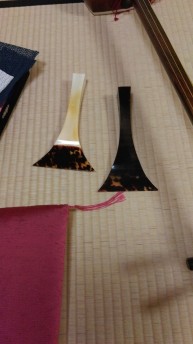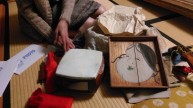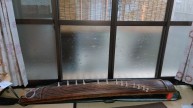This past semester, I decided to continue studying Koto, which I had been playing for roughly half a year at my home institution. As a result, I initially came in with the expectation that lessons would be pretty much the same as my typical group lessons.
In the end, I believe private lessons provided me a unique opportunity to not only learn more technical tricks but also to gain a deeper understanding of music and discussing music in Japanese. Reaching those realizations, however, was initially very difficult. On my first class, especially, I was amazed that after all of my hours and hours of studying Japanese, I didn’t understand a word my teacher said. I later came to realize it was because she used Kansai dialect. If she hadn’t been playing the Koto with me I would have had no idea what she was asking me to do. I was overwhelmed, and even wound up making silly mistakes like saying 行ってきます(ittekimasu=I’ll be back, but used only when you leave your home) after class. However, this language barrier forced me to listen even closer and to constantly ask questions, which thankfully made me more comfortable with my teacher.
Around half-way through the semester, I met a Japanese friend who is studying English and preparing to study abroad next semester. He takes really diligent notes on all the English phrases, idioms, and words that he hears pretty much all of the time. From looking at his notes and its benefits with his language study, I figured I would give it a try for my CIP. It was by far one of the best decisions for my studies. Not only did it let me keep track of new vocabulary and phrases, it helped me pay closer attention to general speaking, be unabashedly inquisitive when I didn’t understand, and opened up different conversations that in turn taught me interesting everyday objects and phrases. For example, tying string into a bow or “bunny ears” is called 蝶々結び(chyou chyou musubi) or a butterfly knot. During my newfound confidence I also began studying Shamisen. This new study unexpectedly lead to a plethora of conversations about different materials, finger and plucking styles, and words to describe the moods associated with certain note changes.
Through my CIP I’ve been able to understand far more Kansai words likeもういっぺん, わからへん、ちゃう、ええ instead of いい、and so much more. Currently I’m working on 春の海 (Haru no Umi), a very difficult traditional koto piece, and look forward to learning more about the different cultural and linguistic words and phrases associated with traditional Japanese music.

Two of my Sensei’s more expensive 撥(ばち)or picks for Shamisen. The white one is made of elephant tusk and tortoiseshell.

This is an antique shamisen from the the Edo period. The face painted is an お多福(おたふく)面 or mask of a homely woman.

This is the koto my sensei lent me to practice throughout the semester. I have it in my 和室(わしつ),or Japanese style room, in my homestay.

Hello Nia! It’s nice to learn some Kansai words from your post, as well as learn about how your various experiences in Kyoto have clicked together in your learning of Japanese (it’s so kind of your sensei to lend you a koto for practice!). Upon your return, how do you think your experience taking koto and shamisen lessons in Kyoto will be applicable to koto and shamisen lessons in your home institution, assuming that you will continue with them? I am also curious about differences, if any, in the teaching styles of your teachers in Kyoto and back at your home institution.
Hey Regina! Yes my teacher has been incredibly kind during my learning process. Not only did she lend me the koto, but she also gave me two new tsume (thinner than mine, so I can play faster for 春の海), hand and lap guards for shamisen, a beginner shamisen book and a CD recording of her playing in a traditional style trio. And yet, even though I received all of these things, I would say it’s hard for me to compare both my teachers. With my home institution koto teacher, she’s usually busy teaching several people at once (albeit not that many), so the level of detail I was taught with is not always possible. In that sense, I think I’ve been able to advance my technical abilities quite a bit through one-on-one lessons. I’ve learned how important it is to figure out what type of feeling to go for when plucking the koto and will try to ask more questions when playing at my home institution. If I were to compare my teachers though, my home institution teacher definitely yells at me more than my CIP teacher, but that’s her personality and she’s been my Japanese teacher several times so she probably doesn’t care about reserving what she wants to say. As for shamisen, I’m not so sure whether I’ll be able to continue, since I don’t know of any shamisen groups or clubs right now. But then again, perhaps they are there and I just don’t know it yet, I’ll have to check it out once I get back.
Hey Nia, it seems like you had an interesting time at your CIP. I have a couple of questions. You said you began prior to your time at KCJS, what made you want to play the koto? Also since you have been in contact with kyoto ben, and Kansai ben do you find yourself using it outside of class with friends or family? Also I don’t think I have heard a koto before do you recommend any songs?
Hi Nick! So I’ve always been a huge music lover (played violin for 10 years, ukulele for a semester, and have thousands of songs in my library) and my Japanese teacher was advertising for new koto club members during my Japanese lecture. I already liked the sound of it from the few times I’ve heard it in movies etc. so after hearing I could learn it for free, decided to go try for fun. Eventually, I got into it more and my teacher encouraged me to buy my own equipment (3爪 for the right thumb, index, and middle fingers) and have been practicing slightly more seriously for close to a year now.
I have not tried using any kansai ben in my conversations, pretty sure I would be judged haha I said おいしいわ once at dinner and my host family kept going on about it, so I’ll probably just stick to not using it unless in a more joking manner.
Yes! There are tons of awesome koto pieces out there. First off pretty much every person who learns koto learns Sakura first (https://www.youtube.com/watch?v=AK51LblcEOw) and here’s a recording of the piece I’m working on now Haru no Umi (https://www.youtube.com/watch?v=qKYMEseTZxE). And on a really cool side note, your question led me stumble upon a Shakuhachi and Koto cover of Taylor Swift’s Shake It Off (https://www.youtube.com/watch?v=tXddHUDUxt0) and Michael Jackson’s Smooth Criminal (https://www.youtube.com/watch?v=zMLScLUrol4) that are both really good in my opinion. Thanks for asking and enjoy!
P.S. Just found one for Nintendo game themes I think you’ll enjoy (https://www.youtube.com/watch?v=92iaeUeeJqY)
Do you feel like the Kyoto dialect has added to the experience of playing the Shamisen? Ie, with a special kind of speaking does it make the playing feel more special? I know in America, we still use certain Japanese words to refer to things in Karate, because the language and the cultural practice are kind of linked…
I’m glad to hear that you’ve been able to tap into the sounds of old Kyoto. Wish you were doing a performance for us…